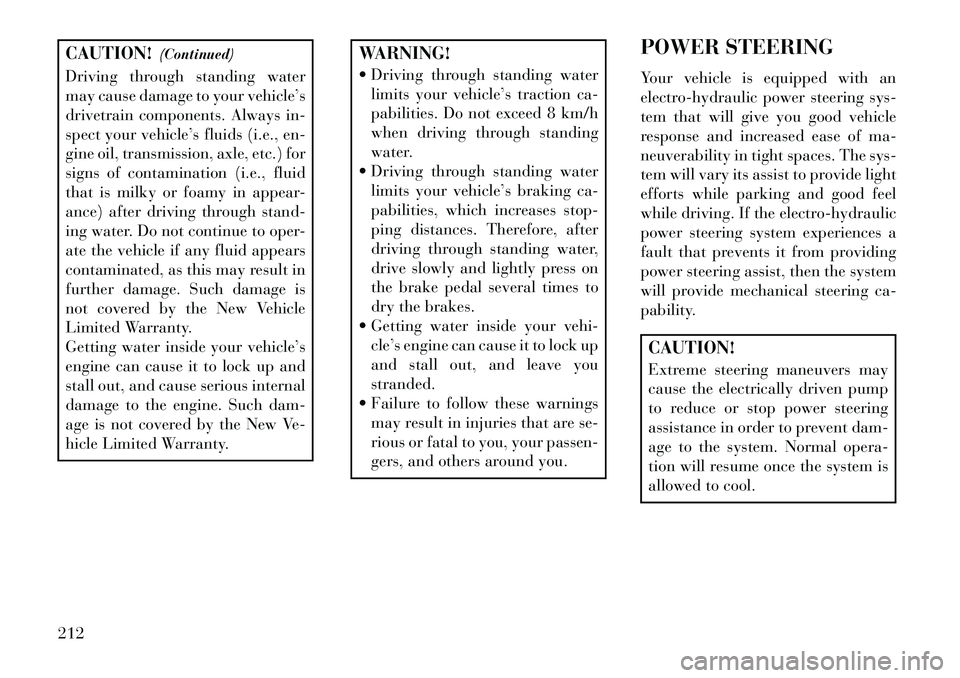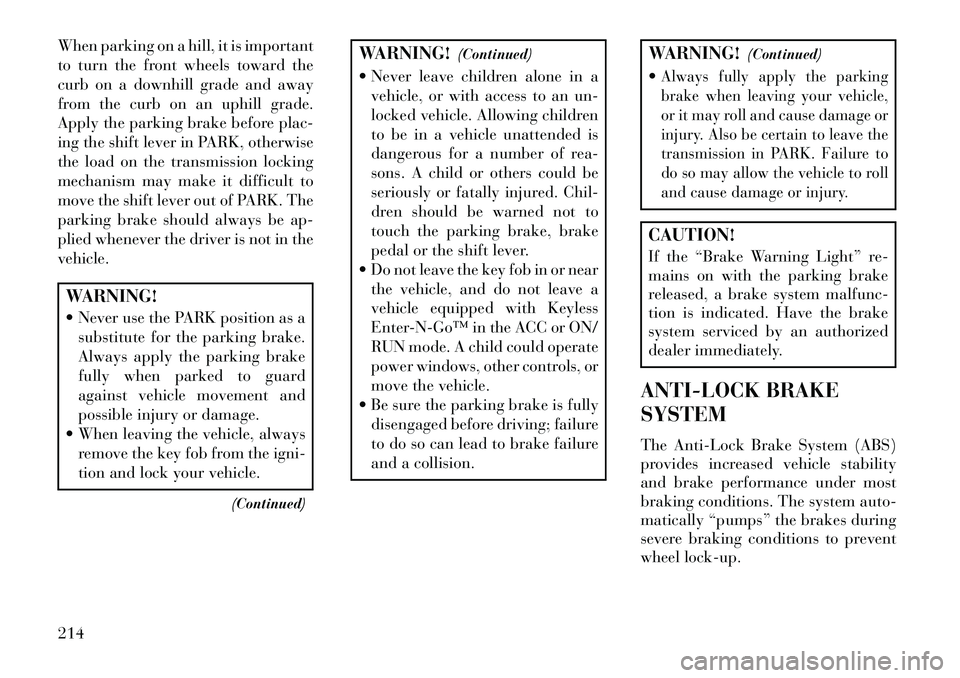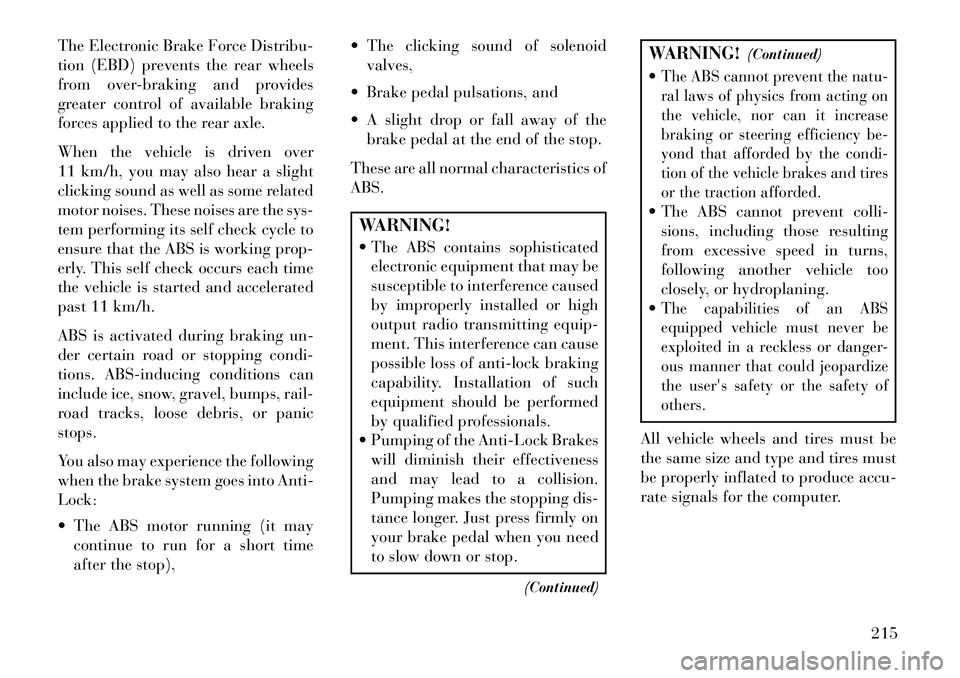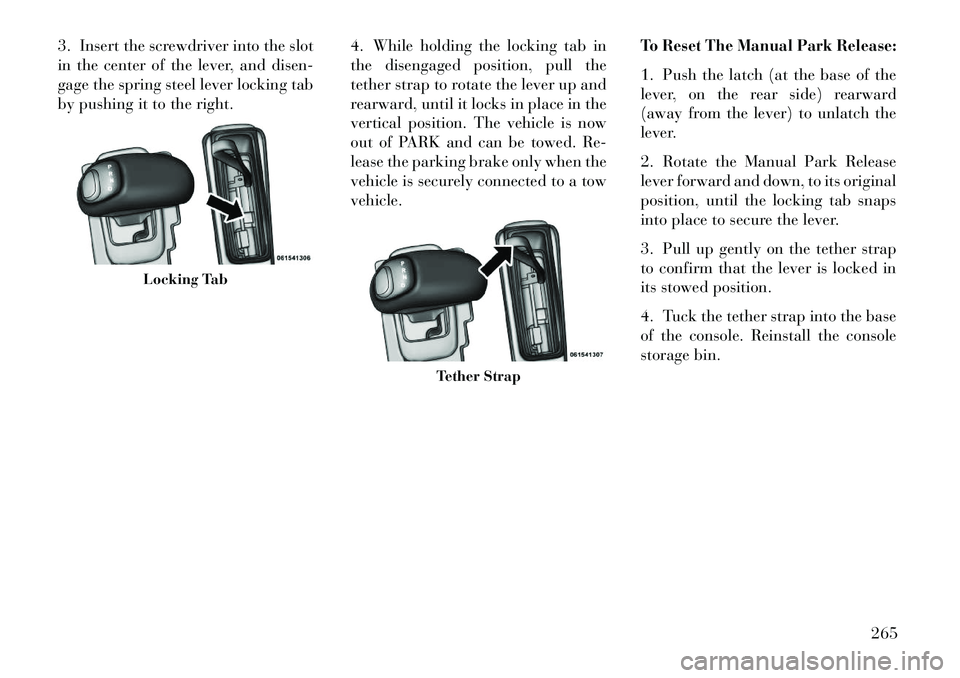lock Lancia Thema 2013 Owner handbook (in English)
[x] Cancel search | Manufacturer: LANCIA, Model Year: 2013, Model line: Thema, Model: Lancia Thema 2013Pages: 336, PDF Size: 3.87 MB
Page 212 of 336

WARNING!(Continued)
Never leave children alone in a vehicle, or with access to an un-
locked vehicle. Allowing children
to be in a vehicle unattended is
dangerous for a number of rea-
sons. A child or others could be
seriously or fatally injured. Chil-
dren should be warned not to
touch the parking brake, brake
pedal or the shift lever.
Do not leave the key fob in or near the vehicle, and do not leave Key-
less Enter-N-Go in the ACC or
ON/RUN mode. A child could
operate power windows, other
controls, or move the vehicle.CAUTION!
Before moving the shift lever outof PARK, you must turn the igni-
tion switch from the LOCK/OFF
position to the ON/RUN position,
and also press the brake pedal.
Otherwise, damage to the shift
lever could result.
(Continued)
CAUTION!(Continued)
DO NOT race the engine when shifting from PARK or NEU-
TRAL into another gear range, as
this can damage the drivetrain.
The following indicators should be
used to ensure that you have engaged
the shift lever into the PARK position:
When shifting into PARK, firmly move the shift lever all the way
forward and to the left until it stops
and is fully seated.
Look at the shift lever position dis- play and verify that it indicates the
PARK position.
With brake pedal released, verify that the shift lever will not move out
of PARK.
REVERSE
This range is for moving the vehicle
backward. Shift into REVERSE only
after the vehicle has come to a com-
plete stop. NEUTRAL
Use this range when the vehicle is
standing for prolonged periods with
the engine running. The engine may
be started in this range. Apply the
parking brake and shift the transmis-
sion into PARK if you must leave the
vehicle.
WARNING!
Do not coast in NEUTRAL and
never turn off the ignition to coast
down a hill. These are unsafe prac-
tices that limit your response to
changing traffic or road conditions.
You might lose control of the ve-
hicle and have a collision.CAUTION!
Towing the vehicle, coasting, or
driving for any other reason with
the transmission in NEUTRAL can
cause severe transmission damage.
Refer to “Recreational Towing” in
“Starting And Operating” and
“Towing A Disabled Vehicle” in
“What To Do In Emergencies” for
further information.
206
Page 218 of 336

CAUTION!(Continued)
Driving through standing water
may cause damage to your vehicle’s
drivetrain components. Always in-
spect your vehicle’s fluids (i.e., en-
gine oil, transmission, axle, etc.) for
signs of contamination (i.e., fluid
that is milky or foamy in appear-
ance) after driving through stand-
ing water. Do not continue to oper-
ate the vehicle if any fluid appears
contaminated, as this may result in
further damage. Such damage is
not covered by the New Vehicle
Limited Warranty.
Getting water inside your vehicle’s
engine can cause it to lock up and
stall out, and cause serious internal
damage to the engine. Such dam-
age is not covered by the New Ve-
hicle Limited Warranty.
WARNING!
Driving through standing water limits your vehicle’s traction ca-
pabilities. Do not exceed 8 km/h
when driving through standing
water.
Driving through standing water
limits your vehicle’s braking ca-
pabilities, which increases stop-
ping distances. Therefore, after
driving through standing water,
drive slowly and lightly press on
the brake pedal several times to
dry the brakes.
Getting water inside your vehi-
cle’s engine can cause it to lock up
and stall out, and leave you
stranded.
Failure to follow these warnings may result in injuries that are se-
rious or fatal to you, your passen-
gers, and others around you. POWER STEERING
Your vehicle is equipped with an
electro-hydraulic power steering sys-
tem that will give you good vehicle
response and increased ease of ma-
neuverability in tight spaces. The sys-
tem will vary its assist to provide light
efforts while parking and good feel
while driving. If the electro-hydraulic
power steering system experiences a
fault that prevents it from providing
power steering assist, then the system
will provide mechanical steering ca-
pability.
CAUTION!
Extreme steering maneuvers may
cause the electrically driven pump
to reduce or stop power steering
assistance in order to prevent dam-
age to the system. Normal opera-
tion will resume once the system is
allowed to cool.
212
Page 220 of 336

When parking on a hill, it is important
to turn the front wheels toward the
curb on a downhill grade and away
from the curb on an uphill grade.
Apply the parking brake before plac-
ing the shift lever in PARK, otherwise
the load on the transmission locking
mechanism may make it difficult to
move the shift lever out of PARK. The
parking brake should always be ap-
plied whenever the driver is not in the
vehicle.WARNING!
Never use the PARK position as asubstitute for the parking brake.
Always apply the parking brake
fully when parked to guard
against vehicle movement and
possible injury or damage.
When leaving the vehicle, always
remove the key fob from the igni-
tion and lock your vehicle.
(Continued)
WARNING!(Continued)
Never leave children alone in a vehicle, or with access to an un-
locked vehicle. Allowing children
to be in a vehicle unattended is
dangerous for a number of rea-
sons. A child or others could be
seriously or fatally injured. Chil-
dren should be warned not to
touch the parking brake, brake
pedal or the shift lever.
Do not leave the key fob in or near the vehicle, and do not leave a
vehicle equipped with Keyless
EnterNGo™ in the ACC or ON/
RUN mode. A child could operate
power windows, other controls, or
move the vehicle.
Be sure the parking brake is fully disengaged before driving; failure
to do so can lead to brake failure
and a collision.
WARNING! (Continued)
Always fully apply the parking
brake when leaving your vehicle,
or it may roll and cause damage or
injury. Also be certain to leave the
transmission in PARK. Failure to
do so may allow the vehicle to roll
and cause damage or injury.CAUTION!
If the “Brake Warning Light” re-
mains on with the parking brake
released, a brake system malfunc-
tion is indicated. Have the brake
system serviced by an authorized
dealer immediately.
ANTI-LOCK BRAKE
SYSTEM
The Anti-Lock Brake System (ABS)
provides increased vehicle stability
and brake performance under most
braking conditions. The system auto-
matically “pumps” the brakes during
severe braking conditions to prevent
wheel lock-up.
214
Page 221 of 336

The Electronic Brake Force Distribu-
tion (EBD) prevents the rear wheels
from over-braking and provides
greater control of available braking
forces applied to the rear axle.
When the vehicle is driven over
11 km/h, you may also hear a slight
clicking sound as well as some related
motor noises. These noises are the sys-
tem performing its self check cycle to
ensure that the ABS is working prop-
erly. This self check occurs each time
the vehicle is started and accelerated
past 11 km/h.
ABS is activated during braking un-
der certain road or stopping condi-
tions. ABS-inducing conditions can
include ice, snow, gravel, bumps, rail-
road tracks, loose debris, or panic
stops.
You also may experience the following
when the brake system goes into Anti-
Lock:
The ABS motor running (it maycontinue to run for a short time
after the stop), The clicking sound of solenoid
valves,
Brake pedal pulsations, and
A slight drop or fall away of the brake pedal at the end of the stop.
These are all normal characteristics of
ABS.
WARNING!
The ABS contains sophisticated electronic equipment that may be
susceptible to interference caused
by improperly installed or high
output radio transmitting equip-
ment. This interference can cause
possible loss of anti-lock braking
capability. Installation of such
equipment should be performed
by qualified professionals.
Pumping of the Anti-Lock Brakes will diminish their effectiveness
and may lead to a collision.
Pumping makes the stopping dis-
tance longer. Just press firmly on
your brake pedal when you need
to slow down or stop.
(Continued)
WARNING!(Continued)
The ABS cannot prevent the natu-
ral laws of physics from acting on
the vehicle, nor can it increase
braking or steering efficiency be-
yond that afforded by the condi-
tion of the vehicle brakes and tires
or the traction afforded. The ABS cannot prevent colli- sions, including those resulting
from excessive speed in turns,
following another vehicle too
closely, or hydroplaning.
The capabilities of an ABS
equipped vehicle must never be
exploited in a reckless or danger-
ous manner that could jeopardize
the user's safety or the safety of
others.
All vehicle wheels and tires must be
the same size and type and tires must
be properly inflated to produce accu-
rate signals for the computer.
215
Page 222 of 336

ELECTRONIC BRAKE
CONTROL SYSTEM
Your vehicle is equipped with an ad-
vanced electronic brake control sys-
tem that include Anti-Lock Brake
System (ABS), Traction Control Sys-
tem (TCS), Brake Assist System
(BAS), and the Electronic Stability
Control (ESC). All four of these sys-
tems work together to enhance vehicle
stability and control in various driv-
ing conditions.Also, your vehicle may be equipped
with Hill Start Assist (HSA), Ready
Alert Braking, and Rain Brake Support.ANTI-LOCK BRAKE
SYSTEM (ABS)
This system aids the driver in main-
taining vehicle control under adverse
braking conditions by controlling hy-
draulic brake pressure. This prevents
wheel lock-up to help avoid skidding
on slippery surfaces during braking.
Refer to “Anti-Lock Brake System” in
“Starting and Operating” for further
information.
WARNING!
The ABS cannot prevent the natu-
ral laws of physics from acting on
the vehicle, nor can it increase the
traction afforded by prevailing
road conditions. The ABS cannot
prevent collisions, including those
resulting from excessive speed in
turns, driving on very slippery sur-
faces, or hydroplaning. The capa-
bilities of an ABS-equipped vehicle
must never be exploited in a reck-
less or dangerous manner that
could jeopardize the user's safety or
the safety of others.
TRACTION CONTROL
SYSTEM (TCS)
This system monitors the amount of
wheel spin of each driven wheel. If
wheel spin is detected, brake pressure
is applied to the slipping wheel(s) and
engine power is reduced to provide
enhanced acceleration and stability. BRAKE ASSIST SYSTEM
(BAS)
This system complements the ABS by
optimizing the vehicle braking capa-
bility during emergency brake ma-
neuvers. This system detects an emer-
gency braking situation by sensing
the rate and amount of brake applica-
tion and then applies optimum pres-
sure to the brakes. This can help re-
duce braking distances.
Applying the brakes very quickly re-
sults in the best BAS assistance. To
receive the benefits of this system, you
must apply continuous brake pedal
pressure during the stopping se-
quence. Do not reduce brake pedal
pressure unless braking is no longer
desired. Once the brake pedal is re-
leased, the BAS is deactivated.
WARNING!
The BAS cannot prevent the natu-
ral laws of physics from acting on
the vehicle, nor can it increase the
traction afforded by prevailing
road conditions. The BAS cannot
(Continued)
216
Page 242 of 336

Tire Pressure Monitoring Low
Pressure WarningsThe TPM Telltale Light will
illuminate in the instrument
cluster and a chime will sound
when tire pressure is low in one or
more of the four active road tires. In
addition, the EVIC will display an
“Inflate Tire to XX” message for a
minimum of five seconds and a "LOW
TIRE" message and a graphic show-
ing the pressure values of each tire
with the low tire pressure values flash-
ing. The recommended cold placard
pressure inflation value is the pressure
value displayed in the "Inflate Tire to
XX" message displayed in the EVIC.
Should this occur, you should stop as
soon as possible and inflate the tires
with a low pressure condition (those
flashing in the EVIC graphic) to the
vehicle’s recommended cold placard
pressure inflation value. Once the sys-
tem receives the updated tire pres-
sures, the system will automatically update, the “Inflate Tire to XX” mes-
sage will no longer be displayed, the
graphic display in the EVIC will stop
flashing, and the TPM Telltale Light
will turn off. The vehicle may need to
be driven for up to 20 minutes above
24 km/h in order for the TPMS to
receive this information.
Service TPMS Warning
If a system fault is detected, the TPM
Telltale Light will flash on and off for
75 seconds and then remain on solid.
The system fault will also sound a
chime. In addition, the EVIC will dis-
play a "SERVICE TPM SYSTEM"
message for a minimum of five sec-
onds and then display dashes (- -) in
place of the pressure value to indicate
which sensor is not being received.
If the ignition switch is cycled, this
sequence will repeat, providing the
system fault still exists. If the system
fault no longer exists, the TPM Tell-
tale Light will no longer flash, and the
"SERVICE TPM SYSTEM" message
will no longer display, and a pressurevalue will display in place of the
dashes. A system fault can occur due
to any of the following:
1. Signal interference due to elec-
tronic devices or driving next to facili-
ties emitting the same radio frequen-
cies as the TPM sensors.
2. Installing aftermarket window
tinting that contains materials that
may block radio wave signals.
3. Accumulation of snow or ice
around the wheels or wheel housings.
4. Using tire chains on the vehicle.
5. Using wheels/tires not equipped
with TPM sensors.
The EVIC will also display a "SER-
VICE TPM SYSTEM" message for a
minimum of five seconds when a sys-
tem fault related to an incorrect sen-
sor location fault is detected. In this
case, the "SERVICE TPM SYSTEM"
message is then followed with a
graphic display with pressure values
still shown. This indicates that the
pressure values are still being received
from the TPM sensors but they may236
Page 252 of 336

TOWING REQUIREMENTS
To promote proper break-in of your
new vehicle drivetrain components
the following guidelines are recom-
mended:CAUTION!
Do not tow a trailer at all duringthe first 805 km the new vehicle is
driven. The engine, axle or other
parts could be damaged.
Then, during the first 805 km
that a trailer is towed, do not
drive over 80 km/h and do not
make starts at full throttle. This
helps the engine and other parts
of the vehicle wear in at the
heavier loads.WARNING!
Improper towing can lead to an in-
jury collision. Follow these guide-
lines to make your trailer towing as
safe as possible:
(Continued)
WARNING!(Continued)
Make certain that the load is se- cured in the trailer and it will not
shift during travel. When traile-
ring cargo that is not fully se-
cured, dynamic load shifts can
occur that may be difficult for the
driver to control. You could lose
control of your vehicle and have a
collision.
When hauling cargo or towing a trailer, do not overload your ve-
hicle or trailer. Overloading can
cause a loss of control, poor per-
formance, or damage to brakes,
axle, engine, transmission, steer-
ing, suspension, chassis structure,
or tires.
Safety chains must always be used
between your vehicle and trailer.
Always connect the chains to the
frame or hook retainers of the ve-
hicle hitch. Cross the chains under
the trailer tongue and allow
enough slack for turning corners.
(Continued)
WARNING! (Continued)
Vehicles with trailers should not be parked on a grade. When
parking, apply the parking brake
on the tow vehicle. Put the tow
vehicle automatic transmission in
PARK. Always, block or "chock"
the trailer wheels.
GCWR must not be exceeded.
Total weight must be distrib-
uted between the tow vehicle
and the trailer such that the
following four ratings are not
exceeded:
1. Max loading as defined on the
“Tire and Loading Information”
placard.
2. GTW
3. GAWR
4.
Tongue weight rating for the
trailer hitch utilized. (This re-
quirement may limit the ability to
always achieve the 10% to 15%
range of tongue weight as a per-
centage of total trailer weight.)
246
Page 266 of 336

NOTE: If the tire becomes over-
inflated, press the Deflation But-
ton to reduce the tire pressure to
the recommended inflation pres-
sure before continuing.
2. Disconnect the TIREFIT kit from
the valve stem, reinstall the cap on the
valve stem and unplug from 12 Volt
outlet.
3. Place the TIREFIT kit in its proper
storage area in the vehicle.
4. Have the tire inspected and re-
paired or replaced at the earliest op-
portunity at an authorized dealer or
tire service center.
5. Replace the Sealant Bottle (1) and
Sealant Hose (6) assembly at your
authorized dealer as soon as possible.
Refer to “(F) Sealant Bottle and Hose
Replacement.”
NOTE: When having the tire ser-
viced, advise the authorized dealer
or service center that the tire has
been sealed using the TIREFIT
service kit.(F) Sealant Bottle And Hose
Replacement:
1. Uncoil the Sealant Hose (6) (clear
in color).
2. Locate the round Sealant Bottle
release button in the recessed area
under the sealant bottle.
3. Press the Sealant Bottle release
button. The Sealant Bottle (1) will
pop up. Remove the bottle and dis-
pose of it accordingly.
4. Clean any remaining sealant from
the TIREFIT housing.
5. Position the new Sealant Bottle (1)
in the housing so that the Sealant
Hose (6) aligns with the hose slot in
the front of the housing. Press the
bottle into the housing. An audible
click will be heard indicating the
bottle is locked into place.
6. Verify that the cap is installed on
the fitting at the end of the Sealant
Hose (6) and return the hose to its
storage area (located on the bottom of
the air pump).
7. Return the TIREFIT kit to its stor-
age location in the vehicle.JUMP-STARTING
PROCEDURES
If your vehicle has a discharged bat-
tery it can be jump-started using a set
of jumper cables and a battery in an-
other vehicle or by using a portable
battery booster pack. Jump-starting
can be dangerous if done improperly
so please follow the procedures in this
section carefully.
NOTE: When using a portable
battery booster pack follow the
manufacturer’s operating instruc-
tions and precautions.
CAUTION!
Do not use a portable battery
booster pack or any other booster
source with a system voltage
greater than 12 Volts or damage to
the battery, starter motor, alterna-
tor or electrical system may occur.WARNING!
Do not attempt jump-starting if the
battery is frozen. It could rupture or
explode and cause personal injury.
260
Page 267 of 336

PREPARATIONS FOR
JUMP-START
The battery is stored under an access
cover in the trunk. Remote battery
posts are located on the right side of
the engine compartment for jump-
starting.
NOTE: The remote battery posts
are viewed by standing on the right
side of the vehicle looking over the
fender.
WARNING!
Take care to avoid the radiatorcooling fan whenever the hood is
raised. It can start anytime the
ignition switch is ON. You can be
injured by moving fan blades.
Remove any metal jewelry such
as watch bands or bracelets that
might make an inadvertent elec-
trical contact. You could be seri-
ously injured.
Batteries contain sulfuric acid that can burn your skin or eyes
and generate hydrogen gas which
is flammable and explosive. Keep
open flames or sparks away from
the battery.
1. Set the parking brake, shift the
automatic transmission into PARK
and turn the ignition to LOCK.
2. Turn off the heater, radio, and all
unnecessary electrical accessories.
3. If using another vehicle to jump-
start the battery, park the vehicle
within the jumper cables reach, set
the parking brake and make sure the
ignition is OFF.
WARNING!
Do not allow vehicles to touch each
other as this could establish a
ground connection and personal
injury could result.
JUMP-STARTING
PROCEDUREWARNING!
Failure to follow this procedure
could result in personal injury or
property damage due to battery
explosion.CAUTION!
Failure to follow these procedures
could result in damage to the
charging system of the booster ve-
hicle or the discharged vehicle.
1. Connect the positive (+)end of the
jumper cable to the remote posi-
tive (+)post of the discharged vehicle.
2. Connect the opposite end of the
positive (+)jumper cable to the posi-
tive (+)post of the booster battery.
Remote Battery Post Locations
1 — Remote Positive (+)Post
2 — Remote Negative (-)Post
261
Page 271 of 336

3. Insert the screwdriver into the slot
in the center of the lever, and disen-
gage the spring steel lever locking tab
by pushing it to the right.4. While holding the locking tab in
the disengaged position, pull the
tether strap to rotate the lever up and
rearward, until it locks in place in the
vertical position. The vehicle is now
out of PARK and can be towed. Re-
lease the parking brake only when the
vehicle is securely connected to a tow
vehicle.
To Reset The Manual Park Release:1. Push the latch (at the base of the
lever, on the rear side) rearward
(away from the lever) to unlatch the
lever.
2. Rotate the Manual Park Release
lever forward and down, to its original
position, until the locking tab snaps
into place to secure the lever.
3. Pull up gently on the tether strap
to confirm that the lever is locked in
its stowed position.
4. Tuck the tether strap into the base
of the console. Reinstall the console
storage bin.
Locking Tab
Tether Strap
265